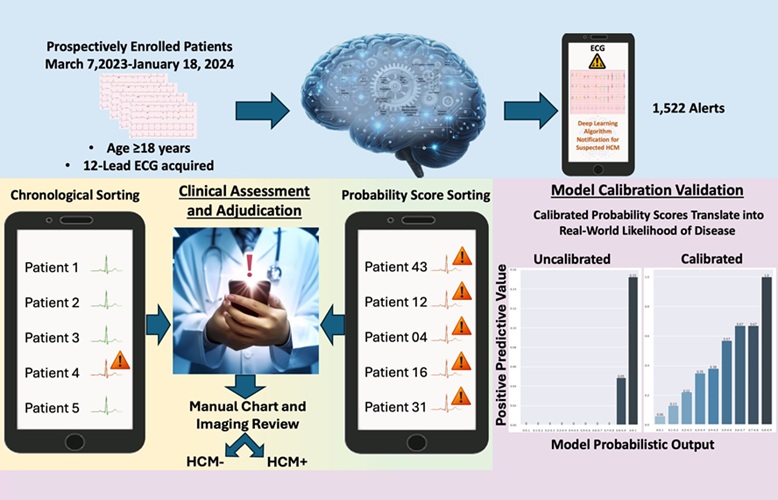Suture-Based Solution Corrects Structural Heart Defects
|
By HospiMedica International staff writers Posted on 05 Dec 2017 |

Image: The Noblestitch EL percutaneous cardiovascular PFO closure system (Photo courtesy of HeartStitch).
An innovative percutaneous suturing system facilitates surgical repair of patent foramen ovale (PFO) and other heart defects.
The HeartStitch (Fountain Valley, CA, USA) Noblestitch EL is a percutaneous cardiovascular suturing and PFO closure system that allows surgeons to place a single polypropylene suture in order to close structural vascular defects. The system is composed of three devices for the release and attachment of non-absorbable polypropylene 4-0 sutures in three different steps:
The NobleStitch EL ‘S’ device allows the surgeon to place the first suture through the septum secundum;
The NobleStitch EL ‘P’ device allows the surgeon to place the second suture through the septum primum;
The “KwiKnot” device allows the surgeon to close the PFO by places a proprietary radiopaque polypropylene knot over the suture, eliminating the need to hand tie a knot.
Advantages of the system for treating PFO include no need for an implanted device, thus eliminating the subsequent risk of implant migration, dislocation, nickel allergy, late onset perforation, and erosion; no risk of thrombosis, and therefore no need for antiplatelet therapy or other medical treatment; and no interference with future transseptal procedures.
“Physicians continuously expressed to me their desire to have suture-based solutions rather than large metal implants left in the heart. Most physicians that have used the NobleStitch EL found it safe, easy to use, and have requested the same suture technologies to replace other implantable clips and devices,” said Professor Anthony Nobles, MD, inventor of the NobleStitch EL and Chairman, CEO and Chief Clinical Officer of HeartStitch. “With every new physician we proctor the response is universally one of 'I intend to use this in my patients as the first choice for closure. Eliminating the need for an anesthesiologist, we can perform the procedure safely under local anesthesia.”
“It is quite efficacious, and is possible to carry out in the majority of patients,” said Achille Gaspardone, MD, of San Eugenio Hospital (Rome, Italy), who presented data from several centers in Italy utilizing the NobleStitch EL system for PFO closure. “Most importantly, the system is safe because there is no metal device left behind, particularly on the left side of the heart.”
When the chambers of a human heart begin to develop, a tunnel is formed between the right and left atria of the heart in order to allow blood to flow directly from the venous to the arterial circulation, circumventing the non-functioning fetal lungs. Following birth, a pressure differential between the right and left atria forms to allow blood flow to the fully functioning lungs, and the tunnel eventually closes completely. When this does not occur, a PFO is formed, allowing blood clots and deoxygenated blood to o cross over to the arterial side. The presence of a PFO has been linked to a number of clinical issues, mainly strokes, migraines and chronic fatigue.
Related Links:
HeartStitch
The HeartStitch (Fountain Valley, CA, USA) Noblestitch EL is a percutaneous cardiovascular suturing and PFO closure system that allows surgeons to place a single polypropylene suture in order to close structural vascular defects. The system is composed of three devices for the release and attachment of non-absorbable polypropylene 4-0 sutures in three different steps:
The NobleStitch EL ‘S’ device allows the surgeon to place the first suture through the septum secundum;
The NobleStitch EL ‘P’ device allows the surgeon to place the second suture through the septum primum;
The “KwiKnot” device allows the surgeon to close the PFO by places a proprietary radiopaque polypropylene knot over the suture, eliminating the need to hand tie a knot.
Advantages of the system for treating PFO include no need for an implanted device, thus eliminating the subsequent risk of implant migration, dislocation, nickel allergy, late onset perforation, and erosion; no risk of thrombosis, and therefore no need for antiplatelet therapy or other medical treatment; and no interference with future transseptal procedures.
“Physicians continuously expressed to me their desire to have suture-based solutions rather than large metal implants left in the heart. Most physicians that have used the NobleStitch EL found it safe, easy to use, and have requested the same suture technologies to replace other implantable clips and devices,” said Professor Anthony Nobles, MD, inventor of the NobleStitch EL and Chairman, CEO and Chief Clinical Officer of HeartStitch. “With every new physician we proctor the response is universally one of 'I intend to use this in my patients as the first choice for closure. Eliminating the need for an anesthesiologist, we can perform the procedure safely under local anesthesia.”
“It is quite efficacious, and is possible to carry out in the majority of patients,” said Achille Gaspardone, MD, of San Eugenio Hospital (Rome, Italy), who presented data from several centers in Italy utilizing the NobleStitch EL system for PFO closure. “Most importantly, the system is safe because there is no metal device left behind, particularly on the left side of the heart.”
When the chambers of a human heart begin to develop, a tunnel is formed between the right and left atria of the heart in order to allow blood to flow directly from the venous to the arterial circulation, circumventing the non-functioning fetal lungs. Following birth, a pressure differential between the right and left atria forms to allow blood flow to the fully functioning lungs, and the tunnel eventually closes completely. When this does not occur, a PFO is formed, allowing blood clots and deoxygenated blood to o cross over to the arterial side. The presence of a PFO has been linked to a number of clinical issues, mainly strokes, migraines and chronic fatigue.
Related Links:
HeartStitch
Latest Surgical Techniques News
- DNA Origami Improves Imaging of Dense Pancreatic Tissue for Cancer Detection and Treatment
- Pioneering Sutureless Coronary Bypass Technology to Eliminate Open-Chest Procedures
- Intravascular Imaging for Guiding Stent Implantation Ensures Safer Stenting Procedures
- World's First AI Surgical Guidance Platform Allows Surgeons to Measure Success in Real-Time
- AI-Generated Synthetic Scarred Hearts Aid Atrial Fibrillation Treatment
- New Class of Bioadhesives to Connect Human Tissues to Long-Term Medical Implants
- New Transcatheter Valve Found Safe and Effective for Treating Aortic Regurgitation
- Minimally Invasive Valve Repair Reduces Hospitalizations in Severe Tricuspid Regurgitation Patients
- Tiny Robotic Tools Powered by Magnetic Fields to Enable Minimally Invasive Brain Surgery
- Magnetic Tweezers Make Robotic Surgery Safer and More Precise
- AI-Powered Surgical Planning Tool Improves Pre-Op Planning
- Novel Sensing System Restores Missing Sense of Touch in Minimally Invasive Surgery
- Headset-Based AR Navigation System Improves EVD Placement
- Higher Electrode Density Improves Epilepsy Surgery by Pinpointing Where Seizures Begin
- Open-Source Tool Optimizes Placement of Visual Brain Implants
- Easy-To-Apply Gel Could Prevent Formation of Post-Surgical Abdominal Adhesions
Channels
Critical Care
view channel
Smart Bandage Monitors Chronic Wounds in Human Patients
A future smart bandage, envisioned as a "lab on skin," could assist both patients and caregivers by not only monitoring chronic wounds but also delivering treatment and accelerating the healing process... Read more
AI Identifies Patients with Increased Lung Cancer Risk Up To 4 Months Earlier
Earlier diagnosis plays a crucial role in improving the prognosis of cancer, as delays in starting therapy are associated with decreased survival rates. In most cases, cancer is first identified when symptoms... Read more
AI Algorithm Identifies High-Risk Heart Patients
Hypertrophic cardiomyopathy (HCM) is a complex condition characterized by the thickening of the heart muscle, which impairs the heart's ability to pump blood effectively. This forces the heart to work... Read more
Next Gen Hemodynamic Monitoring Solution Provides AI-Driven Clinical Decision Support
A new cutting-edge hemodynamic monitoring platform, equipped with predictive artificial intelligence (AI)-based algorithms, is designed to help clinicians proactively manage blood pressure fluctuations... Read morePatient Care
view channel
Portable Biosensor Platform to Reduce Hospital-Acquired Infections
Approximately 4 million patients in the European Union acquire healthcare-associated infections (HAIs) or nosocomial infections each year, with around 37,000 deaths directly resulting from these infections,... Read moreFirst-Of-Its-Kind Portable Germicidal Light Technology Disinfects High-Touch Clinical Surfaces in Seconds
Reducing healthcare-acquired infections (HAIs) remains a pressing issue within global healthcare systems. In the United States alone, 1.7 million patients contract HAIs annually, leading to approximately... Read more
Surgical Capacity Optimization Solution Helps Hospitals Boost OR Utilization
An innovative solution has the capability to transform surgical capacity utilization by targeting the root cause of surgical block time inefficiencies. Fujitsu Limited’s (Tokyo, Japan) Surgical Capacity... Read more
Game-Changing Innovation in Surgical Instrument Sterilization Significantly Improves OR Throughput
A groundbreaking innovation enables hospitals to significantly improve instrument processing time and throughput in operating rooms (ORs) and sterile processing departments. Turbett Surgical, Inc.... Read moreHealth IT
view channel
Printable Molecule-Selective Nanoparticles Enable Mass Production of Wearable Biosensors
The future of medicine is likely to focus on the personalization of healthcare—understanding exactly what an individual requires and delivering the appropriate combination of nutrients, metabolites, and... Read more
Smartwatches Could Detect Congestive Heart Failure
Diagnosing congestive heart failure (CHF) typically requires expensive and time-consuming imaging techniques like echocardiography, also known as cardiac ultrasound. Previously, detecting CHF by analyzing... Read moreBusiness
view channel
Expanded Collaboration to Transform OR Technology Through AI and Automation
The expansion of an existing collaboration between three leading companies aims to develop artificial intelligence (AI)-driven solutions for smart operating rooms with sophisticated monitoring and automation.... Read more















